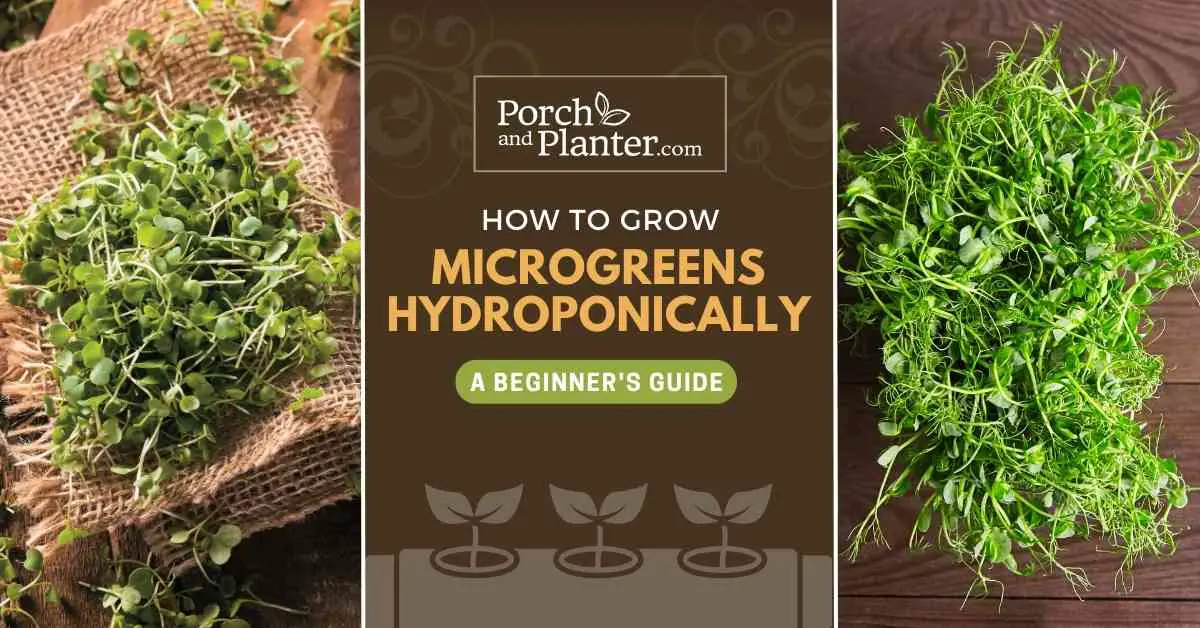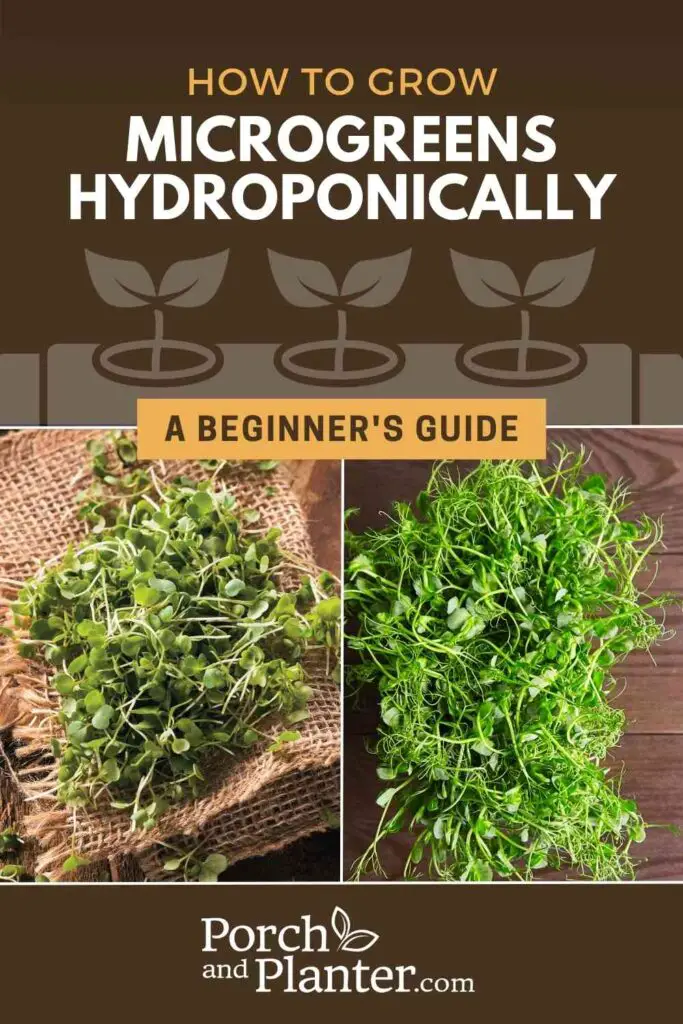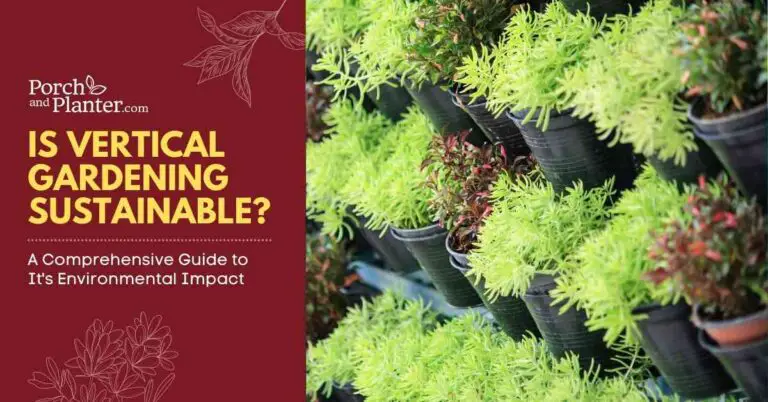How to Grow Microgreens Hydroponically: A Beginner’s Guide

Microgreens are a quick and easy way to add fresh, nutrient-dense greens to your diet. They are young plants that are harvested just a few weeks after germination when they have developed their first set of true leaves. They come in a variety of flavors and textures, and are packed with vitamins and minerals.
Hydroponic microgreen gardening is a popular way to grow these tiny plants. Hydroponics is a method of growing plants without soil, using a nutrient-rich water solution instead. This method is ideal for growing microgreens because it allows for precise control over the growing conditions, resulting in faster growth and higher yields.
When it comes to growing microgreens hydroponically, there are a few key things to keep in mind. First, you will need to choose the right growing medium to provide support for the roots and hold moisture. Second, you will need to ensure that your plants are receiving the right amount of light and nutrients. Finally, you will need to harvest your microgreens at the right time to ensure maximum flavor and nutrition. In this article, we will explore each of these topics in more detail, so you can get started growing your own hydroponic microgreens at home.
Why Hydroponics is the Best Way to Grow Microgreens
Hydroponics is a method of growing plants without soil, using a nutrient-rich water solution instead. When it comes to growing microgreens, hydroponics is the best way to go for a number of reasons.
Controlled Environment
Firstly, hydroponic systems provide a controlled environment that allows for optimal nutrient uptake and efficient use of resources like water and light. This means that microgreens grown hydroponically typically grow faster than those grown in soil. In fact, hydroponic microgreens can be ready for harvest in as little as one to two weeks, compared to three to four weeks for soil-grown microgreens.
More Hygienic
Secondly, hydroponic systems are cleaner and more hygienic than soil-based systems. Because there is no soil involved, there is less risk of contamination from bacteria, pests, and other pathogens. This makes hydroponics an ideal method for growing microgreens, which are often consumed raw and can be susceptible to contamination.
Indoor Growing
Another advantage of hydroponics is that it allows for greater flexibility in terms of location. Hydroponic systems can be set up indoors or outdoors, in small spaces or large ones. This means that growers can set up their hydroponic microgreen farms wherever they have space, without having to worry about tilling the soil, adding nutrients with compost or synthetic fertilizers, or dealing with the weather.
More Sustainable
Finally, hydroponic systems are more sustainable and environmentally friendly than traditional soil-based systems. Because hydroponics uses less water and nutrients than soil-based systems, it is more efficient and produces less waste. In addition, hydroponic systems can be set up to use renewable energy sources like solar or wind power, further reducing their environmental impact.
Choosing the Right Microgreens
When it comes to choosing the right microgreens to grow hydroponically, there are a few things to consider. First and foremost, it’s important to choose microgreens that are well-suited for hydroponic growing. Some of the best options include clover, radishes, alfalfa, collards, kale, and kohlrabi. These microgreens have a short time to harvest and are packed with flavor and nutritional value.
Another factor to consider when choosing microgreens is the space you have available. Some microgreens, like sunflower and pea shoots, can grow quite tall and may not be suitable for smaller hydroponic setups. On the other hand, microgreens like arugula and mustard greens stay relatively compact and are ideal for smaller growing spaces.
It’s also important to consider the taste and texture of the microgreens you choose. Some microgreens, like cilantro and basil, have a strong flavor that may not be to everyone’s liking. Others, like broccoli and cabbage, have a more mild flavor and are more versatile in cooking.
Finally, it’s a good idea to choose microgreens that are easy to grow and maintain. This is especially important if you’re new to hydroponic gardening. Microgreens like radishes and clover are relatively easy to grow and require minimal maintenance, making them a great choice for beginners.
Setting Up Your Hydroponic System
Before you start growing microgreens hydroponically, you need to set up your hydroponic system. This section will guide you through the process of selecting a container, choosing a growing medium, and preparing your water and nutrient solution.
Container Selection
The first step in setting up your hydroponic system is to choose a container. You can use any container that is watertight and has drainage holes. Some popular options include plastic trays, shallow buckets, and even PVC pipes.
When selecting a container, consider the size of your microgreen crop. If you are growing a large quantity of microgreens, you will need a larger container. Additionally, make sure that the container fits in your growing area and can be easily moved if necessary.
Growing Mediums
The growing medium is the material that supports your microgreens and provides them with nutrients. There are several options for growing mediums, including:
- Perlite
- Vermiculite
- Coconut coir
- Rockwool
Each of these growing mediums has its own advantages and disadvantages. For example, perlite is lightweight and easy to handle, but it can be difficult to keep moist. Rockwool is a popular choice because it is sterile and pH neutral, but it can be expensive.
When selecting a growing medium, consider the needs of your microgreens and your budget. You can also experiment with different growing mediums to see which one works best for you.
Water and Nutrient Solution
The final step in setting up your hydroponic system is to prepare your water and nutrient solution. The nutrient solution provides your microgreens with the essential nutrients they need to grow.
You can purchase pre-mixed nutrient solutions or mix your own using fertilizer and water. When mixing your own nutrient solution, make sure to follow the manufacturer’s instructions carefully and test the pH level to ensure that it is within the optimal range for your microgreens.
It is also important to change your nutrient solution regularly to prevent the buildup of harmful bacteria and algae. Aim to change your nutrient solution every 1-2 weeks, or as needed.
Planting and Caring for Your Microgreens
Seeding
When planting microgreens hydroponically, it is important to choose the right kind of seeds. The seeds should be specifically labeled for microgreens and should be untreated, as treated seeds may not germinate as well. The seeds should be spread evenly over the growing medium, with a density of about 10-12 seeds per square inch. After spreading the seeds, cover them with a thin layer of growing medium and mist the surface with water.
Light and Temperature
Microgreens require a lot of light to grow, so it is important to provide them with the right amount of light. A grow light can be used to provide the necessary light if natural light is not sufficient. The temperature should also be monitored, as microgreens grow best in temperatures between 60-75°F. If the temperature is too high or too low, the growth of the microgreens may be stunted or slowed down.
Nutrient Management
When growing microgreens hydroponically, it is important to provide them with the right nutrients. A balanced nutrient solution should be used, with a pH level of around 6.0-6.5. The nutrient solution should be changed every 7-10 days to prevent the buildup of salts and other minerals. It is also important to monitor the electrical conductivity (EC) of the nutrient solution to ensure that the microgreens are receiving the right amount of nutrients.
Harvesting
Microgreens can be harvested when they are about 1-2 inches tall. To harvest, simply cut the microgreens at the base of the stem with a sharp pair of scissors. Rinse the microgreens in cool water and dry them gently with a paper towel. The microgreens can be stored in a plastic bag or sealed reusable container in the refrigerator for up to a week.
Common Problems and Solutions
While hydroponic microgreens can be a great alternative to traditional soil-grown greens, there are some common problems that growers may encounter. Here are a few issues and solutions to help troubleshoot:
1. Overwatering
Overwatering is a common issue in hydroponic systems, and can lead to root rot and other problems. To avoid overwatering, make sure to only water your microgreens when the growing medium is dry to the touch. Consider using a moisture meter to help monitor the moisture levels in your system.
2. Lack of Nutrients
Microgreens require a balanced nutrient solution to grow properly. If your plants are showing signs of nutrient deficiency, such as yellowing leaves or stunted growth, consider adjusting your nutrient solution. Be sure to follow the manufacturer’s instructions carefully when mixing your nutrients.
3. Pests and Disease
While hydroponic systems can be less prone to pests and disease than traditional soil-based systems, they are not immune. To prevent pest and disease issues, make sure to keep your growing area clean and well-maintained. Consider using natural pest control methods, such as ladybugs or neem oil, to keep pests at bay.
4. Insufficient Lighting
Microgreens require adequate light to grow properly. If your plants are not getting enough light, they may become leggy or fail to grow altogether. Consider using LED grow lights to provide your plants with the right spectrum and intensity of light they need to thrive.
5. Temperature Fluctuations
Temperature fluctuations can also cause problems for hydroponic microgreens. Make sure to keep your growing area at a consistent temperature, ideally between 65-75°F. Consider using a thermometer to monitor the temperature in your system.
By addressing these common problems, growers can ensure that their hydroponic microgreens thrive and produce a bountiful harvest.
Conclusion
Growing microgreens hydroponically is a simple and rewarding experience that allows growers to enjoy fresh, nutrient-rich greens right in their homes. With the right equipment, growing medium, and nutrient solution, anyone can become a successful grower in no time. Growing microgreens hydroponically is an easy and rewarding way to enjoy fresh, nutrient-rich greens all year round.







